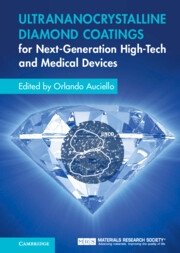Book contents
- Ultrananocrystalline Diamond Coatings for Next-Generation High-Tech and Medical Devices
- Ultrananocrystalline Diamond Coatings for Next-Generation High-Tech and Medical Devices
- Copyright page
- Contents
- Contributors
- Preface
- 1 Fundamentals on Synthesis and Properties of Ultrananocrystalline Diamond (UNCD™) Coatings
- 2 Ultrananocrystalline Diamond (UNCD™) Film as a Hermetic Biocompatible/Bioinert Coating for Encapsulation of an Eye-Implantable Microchip to Restore Partial Vision to Blind People
- 3 Science and Technology of Ultrananocrystalline Diamond (UNCD™) Coatings for Glaucoma Treatment Devices
- 4 Science and Technology of Novel Integrated Biocompatible Superparamagnetic Oxide Nanoparticles Injectable in the Human Eye and External Ultrananocrystalline Diamond (UNCD™)-Coated Magnet for a New Retina Reattachment Procedure
- 5 Science and Technology of Biocompatible Ultrananocrystalline Diamond (UNCD™) Coatings for a New Generation of Implantable Prostheses
- 6 Science and Technology of Novel Ultrananocrystalline Diamond (UNCD™) Scaffolds for Stem Cell Growth and Differentiation for Developmental Biology and Biological Treatment of Human Medical Conditions
- 7 New Generation of Li-Ion Batteries with Superior Specific Capacity Lifetime and Safety Performance Based on Novel Ultrananocrystalline Diamond (UNCD™)-Coated Components for a New Generation of Defibrillators/Pacemakers and Other Battery-Powered Medical and High-Tech Devices
- 8 Science and Technology of Integrated Nitride Piezoelectric/Ultrananocrystalline Diamond (UNCD™) Films for a New Generation of Biomedical MEMS Energy Generation, Drug Delivery, and Sensor Devices
- 9 Science and Technology of Integrated Multifunctional Piezoelectric Oxides/Ultrananocrystalline Diamond (UNCD™) Films for a New Generation of Biomedical MEMS Energy Generation, Drug Delivery, and Sensor Devices
- 10 Biomaterials and Multifunctional Biocompatible Ultrananocrystalline Diamond (UNCD™) Technologies Transfer Pathway
- Index
- References
10 - Biomaterials and Multifunctional Biocompatible Ultrananocrystalline Diamond (UNCD™) Technologies Transfer Pathway
From the Laboratory to the Market for Medical Devices and Prostheses
Published online by Cambridge University Press: 08 July 2022
- Ultrananocrystalline Diamond Coatings for Next-Generation High-Tech and Medical Devices
- Ultrananocrystalline Diamond Coatings for Next-Generation High-Tech and Medical Devices
- Copyright page
- Contents
- Contributors
- Preface
- 1 Fundamentals on Synthesis and Properties of Ultrananocrystalline Diamond (UNCD™) Coatings
- 2 Ultrananocrystalline Diamond (UNCD™) Film as a Hermetic Biocompatible/Bioinert Coating for Encapsulation of an Eye-Implantable Microchip to Restore Partial Vision to Blind People
- 3 Science and Technology of Ultrananocrystalline Diamond (UNCD™) Coatings for Glaucoma Treatment Devices
- 4 Science and Technology of Novel Integrated Biocompatible Superparamagnetic Oxide Nanoparticles Injectable in the Human Eye and External Ultrananocrystalline Diamond (UNCD™)-Coated Magnet for a New Retina Reattachment Procedure
- 5 Science and Technology of Biocompatible Ultrananocrystalline Diamond (UNCD™) Coatings for a New Generation of Implantable Prostheses
- 6 Science and Technology of Novel Ultrananocrystalline Diamond (UNCD™) Scaffolds for Stem Cell Growth and Differentiation for Developmental Biology and Biological Treatment of Human Medical Conditions
- 7 New Generation of Li-Ion Batteries with Superior Specific Capacity Lifetime and Safety Performance Based on Novel Ultrananocrystalline Diamond (UNCD™)-Coated Components for a New Generation of Defibrillators/Pacemakers and Other Battery-Powered Medical and High-Tech Devices
- 8 Science and Technology of Integrated Nitride Piezoelectric/Ultrananocrystalline Diamond (UNCD™) Films for a New Generation of Biomedical MEMS Energy Generation, Drug Delivery, and Sensor Devices
- 9 Science and Technology of Integrated Multifunctional Piezoelectric Oxides/Ultrananocrystalline Diamond (UNCD™) Films for a New Generation of Biomedical MEMS Energy Generation, Drug Delivery, and Sensor Devices
- 10 Biomaterials and Multifunctional Biocompatible Ultrananocrystalline Diamond (UNCD™) Technologies Transfer Pathway
- Index
- References
Summary
This chapter focus on a description of pathways undertaken to transfer the UNCD film technology from the laboratory into the market, through Original Biomedical Implants (OBI-USA) and OBI-México, founded by O. Auciello and colleagues. Topics discussed in this chapter include: 1) Summary of regulatory pathways in different regions of the worldfor approval of medical devices and prostheses; 2) description of pathway to bring to the market a UNCD-coated microchip (artificial retina) implantable inside the eye to restore partial vision to blind people), 2) description of the process to bring to the market a new generation of long life superior performance UNCD-coated prostheses (artificial hips, knees, dental implants, and more); 3) description of pathway to bring into the market a novel retina reattachment process using combined UNCD-coated magnet outside the eye and injection of super-paramagnetic nanoparticles inside the eye, pushing the retina backon to the inner eye’ layer, when attracted by the magnetic field created by the external magnet.
- Type
- Chapter
- Information
- Ultrananocrystalline Diamond Coatings for Next-Generation High-Tech and Medical Devices , pp. 263 - 276Publisher: Cambridge University PressPrint publication year: 2022



